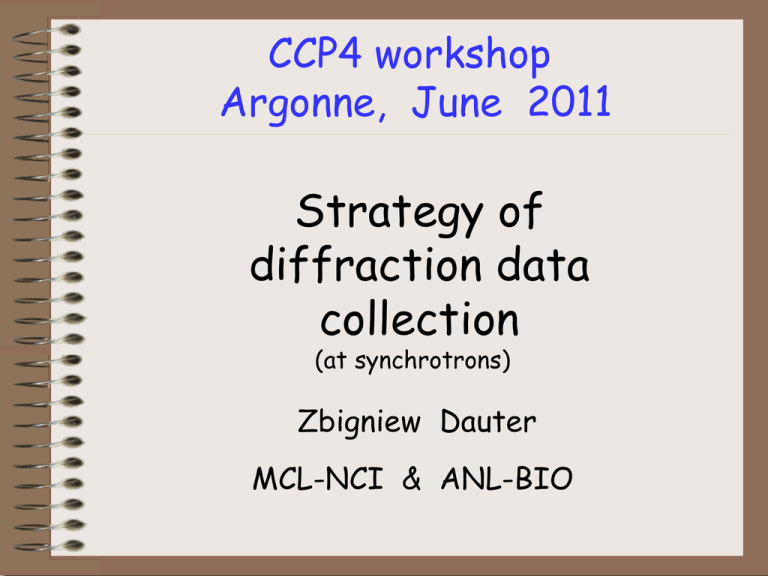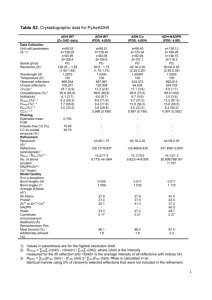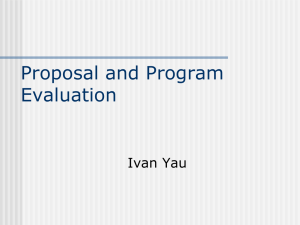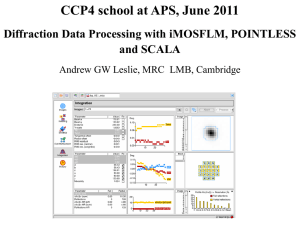Data collection strategy
advertisement

CCP4 workshop Argonne, June 2011 Strategy of diffraction data collection (at synchrotrons) Zbigniew Dauter MCL-NCI & ANL-BIO Advance preparations 1. Crystals must be prepared 2. You must be prepared because Anything that can go wrong, will go wrong (Murphy, 2000 BC) Work at the beam line - Very hectic and/or very boring - Requires quick responses (time is precious) - Full of surprises - technical problems usually on Friday evening… - your best crystals do not diffract - cryo stream develops an ice block - storm in Wisconsin, no power - Rarely fully satisfying, sometimes rewarding (lesson of optimism and perseverance) Data collection process - Easy to screw-up in many ways Involves lots of technical problems But it is science, not technicality Pays off to “engage your brain” Last truly experimental step later mostly computing (and writing-up) which may be repeated many times - good quality data make all subsequent steps much easier Beam line selection - Intensity and brilliance 2nd vs. 3rd generation synchrotron - Collimation, divergence and focusing undulator or bending magnet - Wavelength range - Detector type and size - Crystal characteristics diffraction strength, cell dimensions - Accessibility (APS vs. Spring8) - User friendliness hardware, software and human factor No marvels But synchrotron beam makes no miracles bad crystal at home will be bad also at the synchrotron “This diffraction is so bad – how good we did not bring our best crystals…” Type of experiment Always best to have diffraction data complete, high resolution and accurate but of particular importance are: - Native data for refinement highest resolution (multiple passes) - Molecular replacement medium resolution, no overloads - Heavy atom derivative medium resolution, accurate - Anomalous (MAD, SAD) modest resolution (radiation damage) very accurate and complete at low res. Detector and software In general all CCD or IP detectors and all data processing programs give equally good data (if working properly) Sometimes important is the size of detector front window (e.g. viruses) Some programs are better for particular applications (e.g. d*trek for fine slicing) or more automatic (user friendly) Often experimenter’s experience is more important than data processing program Quality criteria What means “good data” ? Quantitatively Complete All reflections in the asymmetric or the anomalous unit have to be measured and Qualitatively Accurate Intensities have to be meaningful and have realistic error estimates (sigmas) Very easy, but not good to collect indices without intensities (and their error estimations) Quantitative completeness of indices Depends entirely on the geometry and mutual disposition of Reciprocal lattice (crystal) and Ewald sphere (radiation) Ewald construction 3-D illustration of Braggs law: Ewald sphere Reciprocal lattice represents represents n.l = 2.d.sin q radiation crystal Asymmetric unit in reciprocal space Asymmetric unit in reciprocal space is always a wedge bounded by rotation axes (or planes in Laue group): native Triclinic Orthorhombic etc. anomalous – hemisphere - sphere - octant - quadrant It is important to know where to start and how much to rotate the crystal Asymmetric unit in 622 – c axis rotation Asymmetric unit in 622 – a/b axis rotation o Asymmetric unit in 222 – 90 axial o Asymmetric unit in 222 – 90 diagonal Strategy programs Such considerations are easy with crystals in axial orientation, but in arbitrary orientation it may be difficult Good to rely on the strategy programs (This is a minimalist approach, 360o will always give complete data set, but beware of radiation damage !) Still image Increasing rotation Djmax = . p.a 180 d ___________ -h d – resolution a – cell parameter || beam h – mosaicity Beam divergence & mosaicity in direct space Beam divergence & mosaicity in reciprocal space Cell length along the beam Djmax . 180 d ___________ = -h . p a Overloaded profiles Best, strongest reflections – very important for Fourier maps, Pattersons, direct methods, phasing Overload extrapolated 65535 = 216-1 standard profile fitted on shoulders and extrapolated above overload value Missing reflections are never random If missing reflections were spread randomly there would be no serious problem However, for any of the above reasons they are always missing systematically Kevin Cowtan’s duck, back-transformed with missing segment of data: Intensities (and their uncertainties) Very easy to collect indices without intensities however, intensities should be well measured and accompanied by realistic estimations of their uncertainties (errors, s’s) Accuracy criteria of intensities Rmerge (Rsym, Rint ) S S = Shkl Si Ii hkl i |<I> - Ii| __________________ I/s(I) - generally > 2, or 50% of reflections > 3s Multiplicity – generally the higher the better Improved versions of Rmerge Rmerge - bad criterion from statistical point of view (depends on multiplicity) Improved forms (unfortunately rarely used): Rmeas = S S Shkl Si Ii hkl [n/(n-1)] i |<I> - Ii| _______________________________ 1/2 Shkl [1/(n-1)] Si |<I> - Ii| ______________________________ Rp.i.m. = Shkl Si Ii (Diederichs & Karplus, 97) 1/2 (Weiss & Hilgenfeld, 97) Criteria of anomalous data Friedel mates can be treated as equivalent in scaling or not, but kept separate on output indicators of anomalous signal: - higher c2 when Friedels merged - higher R merge when Friedels merged - list of outliers Numerical criteria of anomalous data Ranom + - S = + Shkl |I + I |/2 <______ DF> = <F> ___________________ hkl |I - I | + S + Shkl |F + F |/2 ___________________ hkl |F - F | <D > = ______________ Shkl DF <sDF> Shkl s(DF) F _______ - Rmerge and c2 (Ta6Br12–soaked crystal) Anomalous data - outliers Standard uncertainties (s’s) 2-D detectors do not measure individual X-ray quanta but something proportional therefore counting statistics is not valid and s’s must be corrected for detector “gain” t-plot = <I> - Ii _________ s(I) average = 0.0, s.d. = 1.0 c2 criterion - agreement with expectations Multiplicity More measurements of equivalent reflections lead to more accurate average and s estimation Also scaling and merging is more effective But beware of radiation damage Radiation damage Typical syndrome of radiation damage – first and last data do not agree with average Conclusions X-ray data collection (with 2D detectors) - scientific process, not technicality - irreversible consequences (often) - even more important due to progress in automation, phasing, refinement etc. Always involves a compromise between time, redundancy, completeness etc. - but it should be a wise compromise









